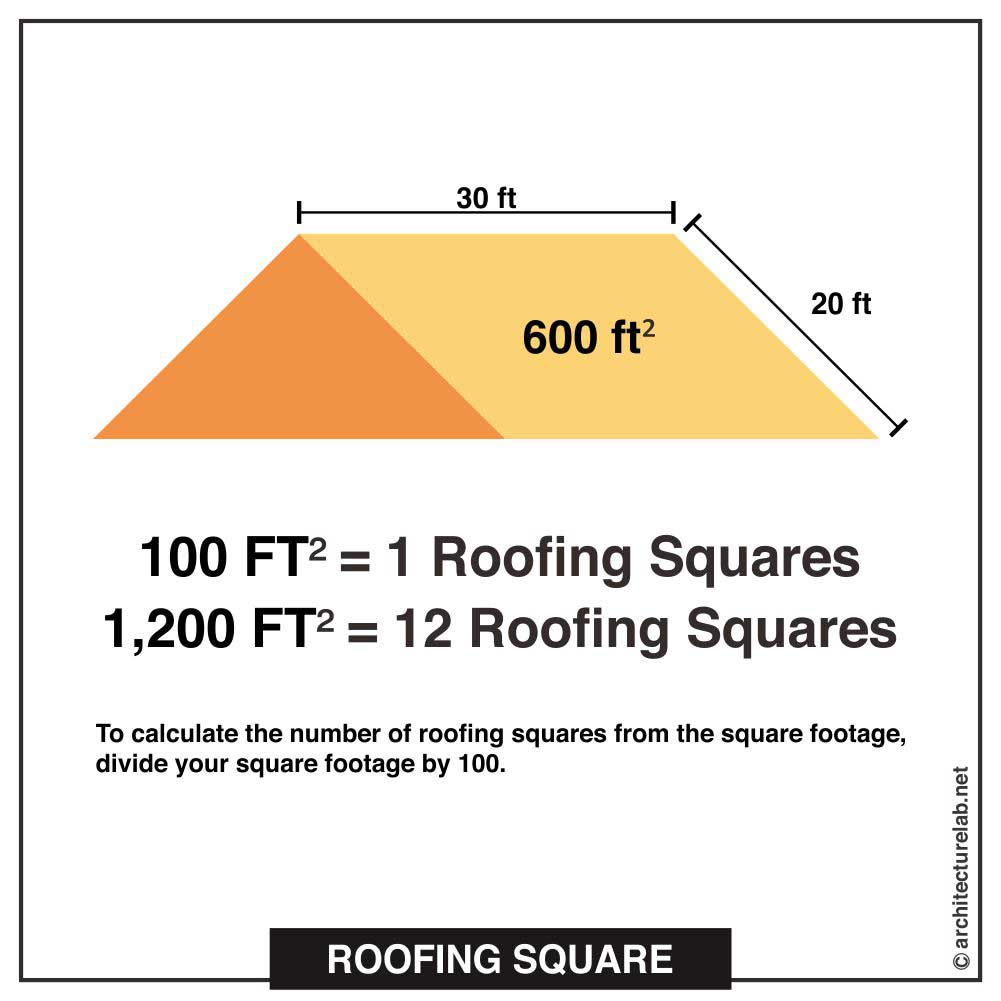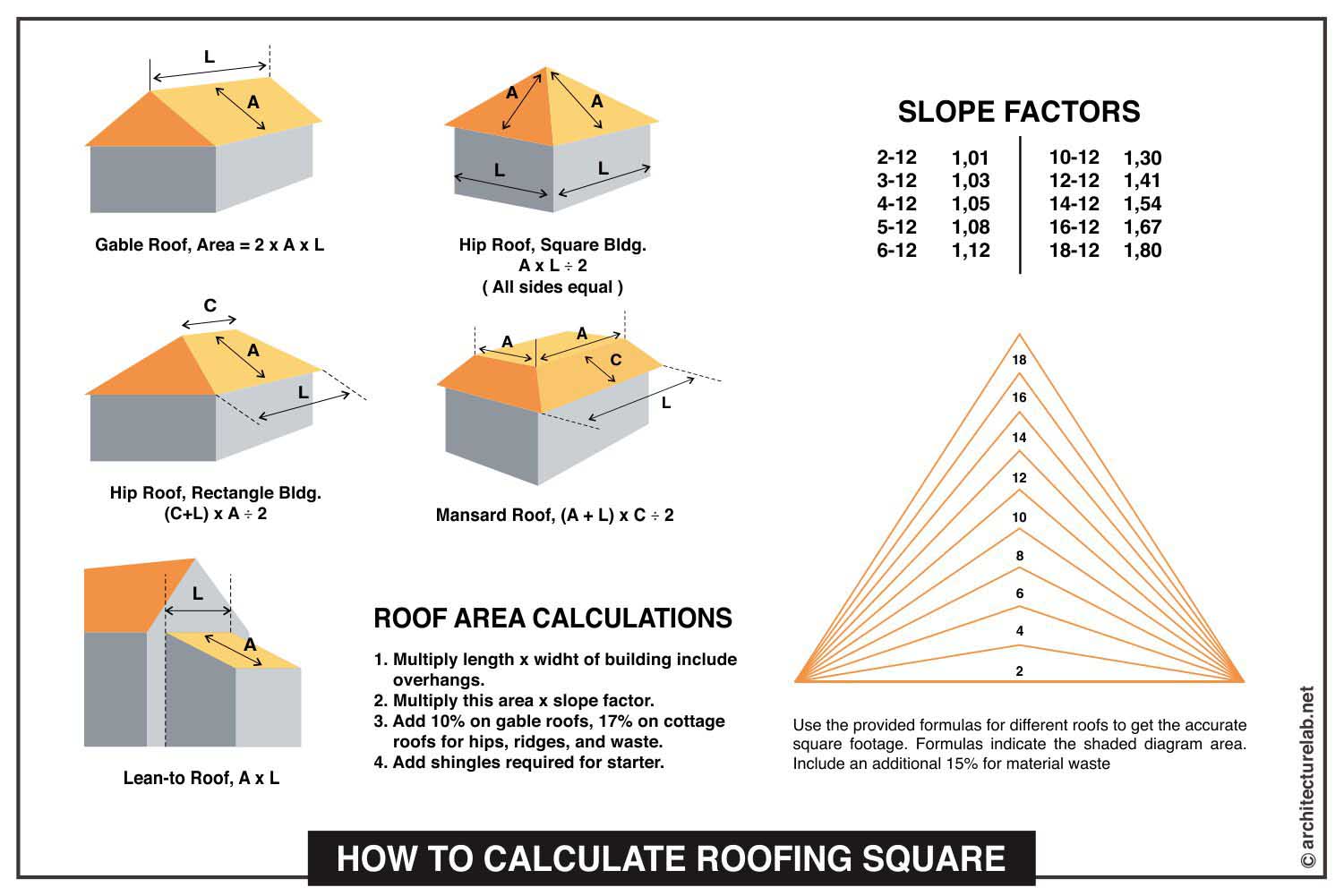Getting a roof replaced can be quite a challenging prospect due to several reasons.
These may include structural complexity, inaccessibility, weather conditions, and more. One of the trickier factors in determining how much material is required is that will affect the total cost of the project. For this purpose, professional roofers and contractors use a roofing square.
This guide aims to shed some light on what a roofing square is and how it is used.
What Is A Roofing Square?
A roofing square is a measurement unit used in the roofing industry to determine the amount of roofing material needed when performing a roof replacement or repair. It is among the most crucial factors that affect the total cost of the replacement process. A roofing square is equal to 100 sq ft.
The number of roofing squares required for a project is calculated by measuring the breadth or width and the length of every plane on the roof. These are then multiplied, and the product is the square footage of each plane. Generally, in the case of gables or other simple roofs, there is one plane at the front and one at the back of the house.
However, there can be more planes depending on the architectural style of the house. The square footage of each plane is added to determine the number of squares in total. Roofing squares provide a standardized measurement unit when performing roof replacements compared to square footage.
That is why it is most important in the roofing and construction industries, though it is highly recommended that homeowners have some knowledge about this measurement unit. Knowing how to calculate your roof size using roofing squares can help save a lot of money when getting your roof replaced.

Taking Measurements
Since a roofing square equals 100 sq ft., you need to determine the number of squares that make up your roof. This can be done by calculating the total square footage and dividing it by 100. The same method is used to measure roofs modified with underlayment or roofing shingles.
These are the steps you need to take to take measurements to calculate the roofing squares needed for a repair or replacement project.
1. Ensure You Have A Secure Hold
To reach the roof, use a sturdy ladder, making sure it is secure so that the chances of falling off are minimized. Also, use proper footwear, such as work boots, while taking measurements on the roof.
2. Measure More Than Once
Even after observing great care while taking measurements, errors can occur, resulting in an increase in cost when ordering roofing materials. It can also lead to material wastage, which is why taking multiple measurements is crucial to ensure maximum accuracy.
3. Calculating The Square Footage
After measuring the length and breadth of various sections of your roof, it is time to calculate the roof size in square feet. To do so, multiply the length of each roof section by its width. For instance, if the length of a section is 30 ft. and the width is 20 ft., the total for one section would be 600 sq. ft.

4. Calculating The Roofing Square
Once you’ve obtained the square footage of the roof, it just needs to be divided by 100 to calculate the roofing squares needed. For instance, if the square footage is 1,000 sq. ft., the number of roofing squares needed would be 1,000/100 = 10. However, some additional amount is usually added to avoid problems like shortage of material.
Considering The Pitch
How high a roof rises per horizontal foot is known as the pitch of the roof. For instance, a 5:10 pitch means the roof rises five inches every ten feet. When measuring the roof, you also need to take into account the pitch, but taking these measurements is not very easy and can even be dangerous.
So, it is better to hire professionals for the job, though knowing how to go about the process can be beneficial. The first thing to do is to determine whether the pitch of the roof is low, medium, or high. After you’ve determined that, you need to take some measurements from the roof using a two-foot level.
Place this level at the roof peak while ensuring its bubble lies in the center. Then, measure the distance between the roof and the level end using a tape measure. Finally, you need to multiply this number by one of the following ones, depending on whether the roof is high, medium, or low:
- For high roofs, multiply by 1.36
- For medium roofs, multiply by 1.185
- For low roofs, multiply by 1.07
The Headlap
Headlap refers to the row of overlapping shingles between rows of shingles that protects the building against water. While a roofing square is usually equal to 100 sq ft, this does not take into account the headlap. The presence of headlap prevents a square of shingles from being 100 sq ft exactly.
That said, the quantity of the roofing material is enough to cover 100 sq ft of the roof.
What Is The Cost Of A Roofing Square?
Knowing about the cost of a roofing square can be very helpful when planning a roof replacement project. But determining it is not very easy as the cost can vary depending on various factors, such as:
- Geographical location of the building
- Roof size
- Roofing materials
- Material quality
- Current market price
- Warranty offered
- Certifications and experience of the contractor
- Time required for replacement
Roofing shingles can be purchased by the square in bundles. In the case of asphalt shingles, three bundles are required to cover one square, but the cost will depend on the manufacturer. The material will affect the price significantly, with some options being more affordable than others.
For instance, ceramic tiles cost less than slate ones but are more expensive than asphalt shingles. Similarly, metal roofs are quite expensive but they are durable and will last you for years.
Cost Per Square
The materials used for roof replacement will determine the cost per square. Asphalt roof shingles are among the most commonly used materials for homes, and roof replacements using this material can cost between $400 and $550 per square. This will also include labor costs and will be affected by your geographical location, as mentioned above.
Other materials, like tiles, will cost more, and an important thing to keep in mind here is that better-quality materials tend to be heavier. Thus, a lesser quantity of it can be fit into a bundle, which is another reason for its higher price.
Number Of Shingles In A Roofing Square
The primary factor determining the number of shingles in a roofing square is its size. Most commonly, three bundles of roofing shingles can be used to cover 100 square feet, which is equal to one roofing square. The number of shingles contained in a bundle can range from 15 to 29, but this depends on the size and type of shingles.
It is also affected by the brand and the number of bundles that make up a square. Some manufacturers indicate the minimum number of shingles included in a package.
Advantages Of Using A Roofing Square
Being an incredibly versatile measurement unit, a roofing square offers several advantages that make roof replacement projects effortless and efficient.
1. Ensures Accurate Measurements
With a roofing square, it is possible to measure roof pitches, angles, and cuts accurately. It allows for quick yet precise calculations resulting in proper alignments, ensuring that roofing materials are installed properly with minimum wastage of effort and resources.
2. Helps Save Time
Besides ensuring accuracy, roofing squares help make measurements and calculations fast, resulting in greater efficiency. Quick calculations help reduce the time and effort involved, especially when it comes to multiple roof sections or intricate roof designs.
3. Multipurpose Tool
Apart from measurements, roofing squares can be used for other purposes. They can be used as a guide for perpendicular cuts, as a straightedge, or even for layouts for stair stringers and rafters.
4. Ensures Consistency
A roofing square can ensure consistent measurements and angles throughout the project. Consistency is crucial for structural integrity and can prevent major problems, such as water leaks, later on.
5. Promotes Safety
Since the measurements done using a roofing square are highly accurate, the chances of errors during installation are minimized. This means issues like improper installations and weak joints that can affect the durability of the roof are eliminated.
Roofing Squares – Best Use Cases
1. Intricate Roof Designs
Roofing squares can be used in almost all types of roofing projects but are most useful if you have a steep roof, such as a mansard roofing or gambrel roof. Compared to these, measuring gable roofs is quite easy as they have simpler designs and do not require as detailed measurements.
In the case of gambrel or mansard roofs, a major factor to consider is waste, which occurs when shingles have to be adjusted into tight spaces by cutting them. This generally happens when shingles need to be placed along dormers or in the form of valleys. Sometimes, they may not even be installed evenly along the deck of the roof.
With the help of roofing squares, the amount of material that remains unused can be drastically reduced in the case of complex roof designs. Additionally, they can help reduce the amount of money and time required for the project, as mentioned previously.
2. Laying Stair Rafters And Stair Stringers
Another significant advantage of a roofing square is that it is very well-suited for checking whether a section of the roof is perfectly square or not. It can also come in handy for wide board marking and laying rafters and stair stringers.
In all these situations, roofing squares play an important role in quality control by providing a consistent reference for the area and the size of the roof. They help ensure durability and uniformity in roof repairs and installations.
3. Non-traditional Roofing Materials
Roofing squares are also very helpful when working with non-traditional roofing materials, like rolled roofing and vegetative roofing. Rolled roofing, which is usually used for flat or low-slope roofs, requires highly precise cuts and accurate measurements. A roofing square simplifies the calculation involved in determining the exact quantity of material needed, making it easy for the contractors to trim the material accurately for the best fit.
Similar to rolled roofing, roofing squares can simplify the roof replacement process if you intend to use vegetative roofing. With the growing popularity of sustainable options, vegetative roofing is becoming rapidly popular and involves growing living vegetation on the roof surface.
In this case, a roofing square not only ensures accurate calculations but also helps determine the most effective planting design across the roof. Contractors can even design the roof when tackling a roof leak repair or new installation for easy maintenance while maximizing cost-effectiveness.
4. Creating Layouts And Guides
Roofing squares can be used to create layout lines and guides very easily because they provide a standardized reference point. In addition, they help determine the spacing and alignment of various roofing components. They also help in setting angles and ensuring symmetry when drawing up layouts to be used for installing shingles and other roofing materials.
Conclusion
It can be seen that a roofing square is one of the most indispensable tools used in the construction industry. Being an extremely versatile tool, roofers and carpenters everywhere rely on it a great deal when undertaking different types of roofing projects.
Apart from making measurements easy and ensuring accuracy and precision, roofing squares can be used when working with different roofing materials and guarantee professional results. More importantly, they help save time and resources and ensure safety when undertaking roofing repair projects.
Just make sure to follow safety precautions when taking measurements on the roof and calculating the roofing squares needed for your project.


